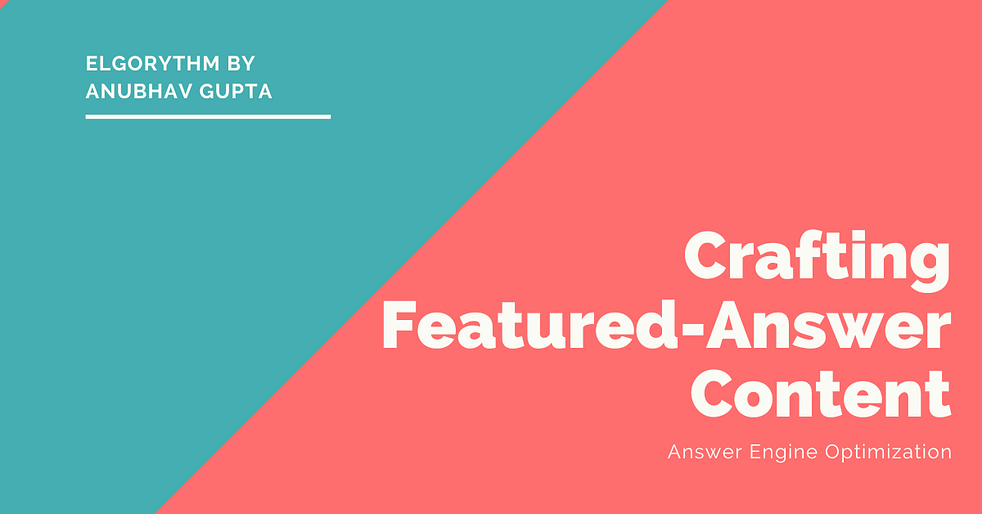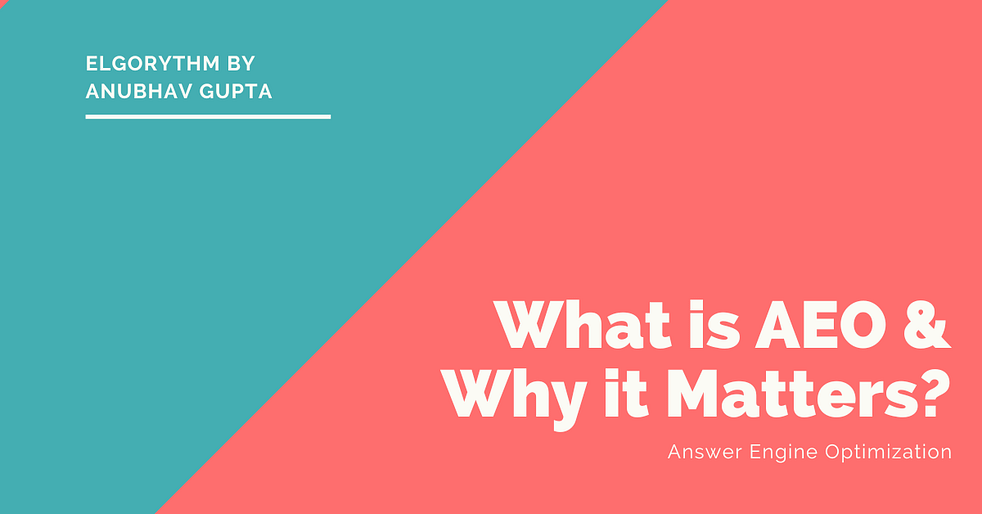I. Introduction: The Dawn of Answer Engine Optimization
The digital landscape is in a constant state of flux, fundamentally reshaping how individuals interact with search platforms and consume information. The traditional emphasis of Search Engine Optimization (SEO) on merely ranking for specific keywords is steadily giving way to a more dynamic environment. Search platforms, the results they deliver, and the very nature of user engagement are undergoing a significant transformation.1 Users today anticipate and often receive quick, direct answers presented immediately within the search results themselves, a development that markedly enhances their overall experience.1 This profound evolution is largely propelled by the increasing prevalence of conversational and voice-based searches, where individuals interact with search engines in a manner akin to conversing with another human.1
In this evolving context, Answer Engine Optimization (AEO) emerges not as a replacement for traditional SEO, but rather as an advanced, complementary layer. AEO’s primary objective is to deliver direct, immediate answers that precisely fulfill a user’s query, moving beyond the sole aim of elevating keyword rankings in search engines.1 The cornerstone of this approach is what is referred to as “Featured-Answer Content.” While this specific term may not be explicitly defined in foundational texts, it is clearly implied by the concept of “featured snippets” – content meticulously engineered to provide swift, concise, and direct answers that appear prominently at the very top of search results.1 This strategic focus on direct answers represents a significant shift in how websites strive for online visibility, functioning as an additional step to traditional SEO strategies.1
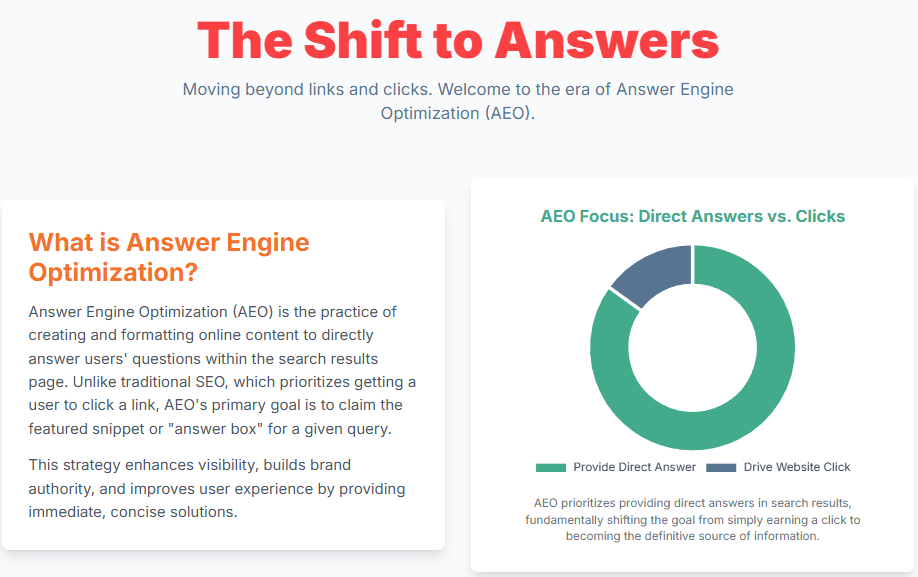
By meticulously aligning content with the evolving user intent and adapting to these new conversational search behaviors, businesses can significantly elevate the user experience.1 This strategic alignment, in turn, directly contributes to improved general search visibility and an enhanced overall online presence.1 Implementing AEO strategies ensures that search results consistently display the most relevant content, leading to a measurable increase in organic traffic and a superior user journey.1
One significant implication of AEO’s focus on direct answers is the rise of the “zero-click” search phenomenon. When an answer is provided directly on the search results page, users may not need to click through to a website to satisfy their query.1 While this might initially seem counterintuitive for a goal of “high traffic,” the strategic value lies in becoming the trusted source. Content that consistently appears as a featured answer, even if it doesn’t generate an immediate click, builds considerable brand recognition and establishes implied authority. This elevated trust and visibility can lead to future direct visits, brand-specific searches, or conversions further down the engagement funnel. Therefore, the “high traffic” derived from AEO stems from increased overall visibility and credibility, fostering a broader spectrum of engagement rather than solely relying on immediate click-throughs.
Another crucial aspect of this evolution is understanding AEO as a strategic progression rather than a complete overhaul. The framework consistently positions AEO as an “extra step” or an “addition” to existing SEO strategies.1 This distinction is vital because it clarifies that the aim is not to abandon established SEO principles but to evolve them to meet the demands of contemporary users and the capabilities of advanced search technologies. Businesses that overlook AEO will inevitably find themselves at a disadvantage, as user behavior has already shifted significantly 1, rendering traditional SEO alone insufficient for comprehensive online visibility. Consequently, AEO is not merely a novel tactic; it represents a necessary strategic adaptation essential for maintaining relevance and competitiveness in the current and future digital landscape. A truly holistic digital strategy must now inherently incorporate AEO as a core component.
II. Decoding Featured-Answer Content: A New Paradigm
Featured-Answer Content is specifically constructed to deliver direct, concise answers, manifesting prominently as “featured snippets” or within “answer boxes” directly on the search engine results page.1 Traditional SEO, in stark contrast, primarily concentrates on achieving higher keyword rankings across numerous web pages, with its main objective being to increase organic traffic through user clicks to those pages.1 AEO, and by extension, the content designed for it, operates on a fundamentally different principle. Its purpose is to provide short, clear answers immediately on search results pages or through voice assistants, leveraging advanced AI and machine learning capabilities to comprehend natural language.1 This distinction underscores a shift from merely directing users to a website to directly satisfying their information needs at the point of search.1
The paramount objective of AEO is to position content as the authoritative source for individuals seeking direct answers across a variety of search platforms, including conversational interfaces like Google Assistant and Perplexity.1 This necessitates an unwavering focus on prioritizing user needs above all else. The design of such content should deliver immediate value, frequently satisfying the user’s query without requiring them to navigate away from the search results page to an external website.1 The goal is not merely to achieve a high ranking, but to be the definitive solution for users requiring immediate information.1
Voice search has emerged as an exceptionally powerful and widespread tool, with users increasingly employing full, conversational sentences when interacting with virtual assistants such as Siri and Alexa.1 This represents a significant departure from the more simplistic, keyword-based queries of the past. AI assistants are highly proficient at interpreting complex user intent and delivering rapid responses, which means that content developed for the web must now seamlessly incorporate concise answers that naturally align with spoken language patterns.1 User behavior has undergone a profound transformation; instead of typing basic keywords like “Indian restaurants,” individuals now pose more detailed, conversational questions such as “Which Indian restaurants near me are top-rated?”.1 This evolution necessitates a reevaluation of digital marketing strategies through the lens of AEO, emphasizing natural language and a deep understanding of user intent.1
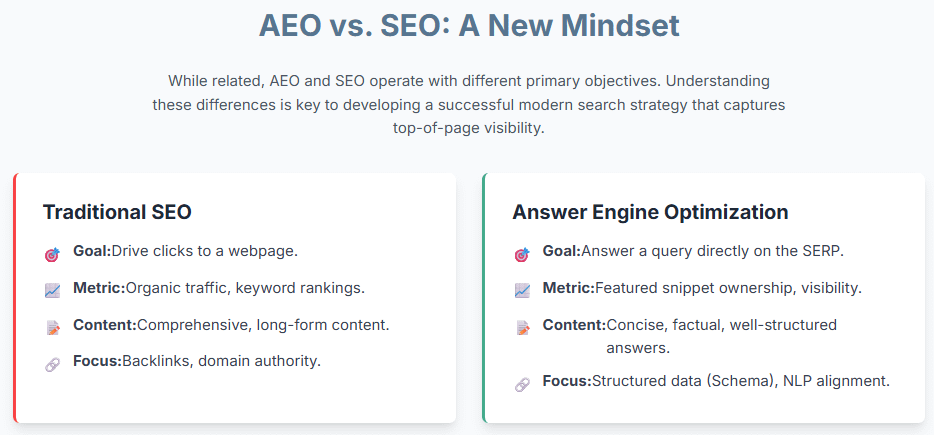
The pervasive emphasis on “conversational queries” and “natural language” indicates that content creation must fundamentally evolve from a keyword-centric approach to one that mirrors human conversation. This goes beyond simply using long-tail keywords; it requires understanding the subtleties of syntax, common phrasing, and even the implied context within spoken questions. The objective is not just to match keywords but to answer questions as a human would, demonstrating a deeper comprehension of the user’s underlying need. This calls for a more intuitive and empathetic approach to content creation, where the content flows naturally as if providing a direct response to a spoken query.
Furthermore, the document highlights that traditional SEO prioritizes “mobile responsiveness and how the website is built,” while AEO places “more weight on structured data and formats that work well with voice”.1 This distinction points to a significant shift in optimization focus from screen-based consumption (e.g., mobile devices) to audio-based consumption (e.g., voice assistants, smart speakers). The implication is that content needs to be optimized not only for
what is searched but also for how and where it is consumed. A concise, direct answer is ideally suited for a voice assistant that reads it aloud, whereas a detailed blog post might be more appropriate for a mobile screen. This necessitates a multi-modal content strategy, where the format and structure of content are tailored to its primary consumption device.
To further clarify the distinct yet complementary nature of these two optimization approaches, the following table provides a strategic comparison:
Table 1: AEO vs. SEO: A Strategic Comparison
Aspect | Traditional SEO | Answer Engine Optimization (AEO) |
Primary Goal | Drive organic traffic, increase click-throughs | Provide direct, concise answers, enhance user experience |
Main Focus | Keyword rankings, website authority | Featured snippets, answer boxes, voice search results |
Content Format | Detailed blog posts, landing pages, articles | Short, structured answers (bullet points, lists, tables) |
User Interaction | Click-through to website for information | Immediate answers on SERP (often zero-click), voice responses |
Key Technologies | Backlinks, site architecture, keyword density | AI, Machine Learning, Natural Language Processing, Structured Data |
Device Focus | Desktop, Mobile responsiveness | Voice assistants, Smart speakers, Mobile (SERP snippets) |
Example Query | “Indian restaurants” | “Which Indian restaurants near me are top-rated?” |
III. The NLP Advantage: Understanding User Intent for AEO
AEO strategies are intricately linked with advancements in natural language processing, machine learning, and broader natural language understanding. These technologies are fundamental to significantly increasing content visibility in the context of modern search results.1 NLP, in particular, empowers search engines to transcend simplistic keyword matching, enabling them to grasp the subtle nuances and true intent behind complex, conversational queries.1 This capability allows platforms to interpret user intent and provide the most relevant response to questions posed in a natural, everyday manner.1
Understanding user intent within the AEO framework extends far beyond the surface-level question. It demands a deep comprehension of the underlying meaning, the user’s genuine desire, and what they truly aim to discover through their search.1 Content creation must therefore fully embrace natural language, mirroring how individuals speak in their daily conversations. The ultimate objective is to prioritize the needs of the users, ensuring the content directly addresses their queries in a human-like and empathetic manner.1 This involves crafting content that is short, matches how people talk, and consistently puts the needs of users first.1
The repeated emphasis on “understanding user intent” and “natural language” as central to AEO suggests that NLP is not merely a technical tool; it is the underlying technology that enables search engines to empathize with the user’s query. For content creators, this translates into a fundamental shift from a purely analytical, keyword-driven mindset to a more empathetic one. Instead of asking “What keywords should be targeted?”, the more pertinent question becomes “What is the user truly trying to achieve or understand when they phrase their query this way?” This profound understanding, facilitated by NLP’s capabilities within search engines, is precisely what allows content to genuinely resonate with user needs and be selected as the definitive featured answer. This moves content from mere information delivery to authentic problem-solving.
Furthermore, the discussion highlights “changing user behavior” and the significant impact of “AI assistants”.1 This points to a continuous, dynamic feedback loop between user interaction and NLP development. As users increasingly adopt more conversational search patterns, such as voice queries, AI and NLP models are continuously trained on this new, richer data, becoming progressively more sophisticated at understanding natural language. In turn, this improved understanding by search engines encourages even more users to adopt conversational querying. For content strategists, this means AEO strategies are not static; they must be continuously updated to align with the evolving capabilities of NLP and the subsequent shifts in user behavior. This creates a need for ongoing research and adaptation to maintain content relevance.
IV. Strategic Pillars for Crafting Featured-Answer Content
A. Intelligent Keyword Research for Conversational Queries
Thorough keyword research remains an indispensable practice, but its focus has significantly evolved. It is now imperative to uncover the precise questions that users, particularly those within specific demographics, are actively asking.1 A deep understanding of this underlying search intent empowers a business to provide clear, direct answers, enabling its content to genuinely stand out on answer engines.1 This goes beyond simply identifying popular terms; it involves discerning the user’s ultimate goal behind their query.
To conduct this advanced form of keyword research, it is beneficial to utilize tools like Google Search Console to analyze conversational queries, identifying the common phrases and questions that an audience frequently employs.1 Close attention should be paid to modifiers such as “best,” “how to,” or “where,” as incorporating these helps refine search queries and makes content more useful, especially when targeting local audiences.1 Strategically integrating location-specific keywords is crucial for effectively targeting “near me” searches, which can significantly boost local SEO rankings and overall AEO performance.1 Additionally, leveraging AI-powered tools can help identify emerging trends in natural language searches, ensuring content remains ahead of the curve and aligned with evolving user behaviors.1
This reframing of keyword research positions it less as a way to simply find terms, and more as a method to “find out what questions users usually ask” and “know the search intent”.1 This implies that for AEO, keyword research is less about raw search volume and more about
understanding the user’s underlying problem or information need. By analyzing conversational queries and modifiers, content creators are essentially performing a form of digital ethnography, gaining deep insight into the user’s thought process and natural expression. This transforms keyword research from a purely technical, data-driven task into a more user-centric, strategic activity focused on empathy and problem-solving.
Furthermore, the emphasis on “location-specific keywords” and “near me” searches 1 directly links traditional local SEO tactics to AEO success, particularly in the context of voice search.1 This indicates that for many businesses, especially those with physical locations or serving specific geographic areas, local optimization is no longer a separate SEO tactic but a critical, integrated component of their AEO strategy. A highly localized, direct answer, such as “best pizza near me,” is precisely what a voice assistant user often seeks, making localized featured snippets exceptionally valuable for driving relevant traffic.
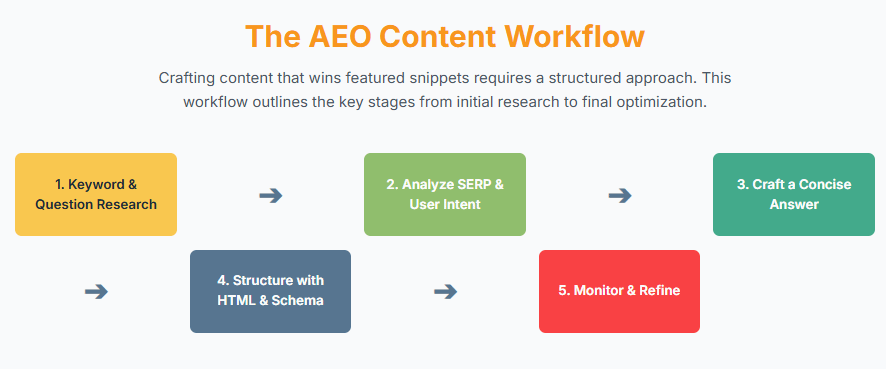
B. Structuring Content for Instant Answers & Featured Snippets
The fundamental key to optimizing content for featured snippets lies in adopting an “answer-first” approach, providing quick, direct answers right at the very beginning of the content.1 This involves commencing with simple, clear headings, immediately followed by concise, short paragraphs that directly address the core questions.1 This structural prioritization ensures that the most critical information is instantly accessible, catering to the user’s desire for immediate solutions.1
To significantly enhance readability and boost search visibility, it is crucial to utilize highly scannable formats such as bullet points, clear numbered lists, or tables.1 These formats are specifically designed for rapid information consumption, allowing users to quickly digest complex information. Such structured presentation methods not only make content more useful and digestible for users but also measurably improve AEO performance by making it easier for search engines to extract and display direct answers.1 AEO actively encourages the use of bullet points or quick-answer paragraphs to help individuals obtain information without delay.1
When crafting content, it is paramount to consistently employ natural language that mirrors everyday conversation. The focus must be intently on the audience, particularly given the increasing prevalence of conversational searches.1 Answers to user questions should be formulated in a way that sounds natural and conversational, adopting a simple, friendly, and consistently humanized tone. This approach is highly effective for building trust with the audience and enhancing user engagement.1 The goal is to ensure the writing is short, matches how people talk, and prioritizes user needs.1
The emphasis on “bullet points or clear lists,” “tables,” and the objective to “help people read fast” 1 underscores that scannability is paramount for Featured-Answer Content. This is not merely about facilitating information extraction for search engines; it is fundamentally about catering to the modern user’s shrinking attention span and immediate desire for answers. If a user can quickly scan and locate the answer within a snippet or a brief section, they are considerably more likely to engage with the content, even in a “zero-click” scenario. This leads to higher user satisfaction, reinforces the content’s perceived authority, and can foster brand recall for future queries.
Furthermore, while structured data (schema markup) is a distinct technical element, the explicit guidance on using “simple headings,” “short paragraphs,” “bullet points,” and “lists” 1 for featured snippets suggests that the
internal content structure itself serves as a powerful, inherent signal to AI and NLP models. These models are engineered to efficiently extract information from well-organized and logically structured text. Therefore, adopting these human-readable, logical structures is not solely for user experience; it is a direct optimization for how AI processes and selects content for direct answers. It functions as a form of “structured data” embedded within the content’s presentation, even before explicit schema markup is applied, making it significantly easier for machines to “understand” the answer.
C. Leveraging Structured Data Markup for AEO Dominance
Structured data markup is an indispensable tool for enhancing online visibility. It provides search engines with precise, machine-readable context about content, significantly improving their ability to accurately understand it.1 By implementing schema markup, a business can unlock the potential to display rich snippets in search results. These visually appealing enhancements not only elevate the user experience but also boost engagement with the site.1 Crucially, this structured setup directly assists content in appearing in highly coveted answer boxes and voice search results, thereby maximizing its exposure and relevance.1 Applying the right schemas for an industry can also improve keyword rankings, driving more organic traffic and enhancing overall search performance.1
Schema markup provides clear, structured data that helps search engines interpret the content on a website.1 Several key types are particularly beneficial for AEO. These include
LocalBusiness schema, which helps display location and contact details; Product schema, which is highly advantageous for online stores; FAQ schema, designed to provide direct answers to common user questions; and Review schema, which allows for the display of customer ratings to build trust.1 The
FAQ schema is especially powerful for delivering direct, concise answers to user questions, making content highly eligible for featured snippets and improving user experience.1
To maximize visibility through structured data, it is advisable to begin implementation with thorough keyword research to identify the most important words and phrases that align with user intent.1 This ensures that the schema targets relevant queries. Integrating schema markup specifically designed to provide clear and concise answers to user queries significantly increases content’s chances of being selected for featured snippets.1 Given the dynamic nature of the search landscape, it is prudent to continuously monitor search behaviors and periodically update structured data implementation. This proactive approach ensures content remains relevant and visible in an ever-changing environment, enhancing the user experience and keeping content useful for searchers.1
The repeated emphasis that structured data “helps search engines accurately understand your content” 1 and “better know and sort the content” 1 indicates that schema markup is not merely a technical add-on; it serves as a critical “translation layer.” This layer allows complex AI algorithms to quickly and unambiguously parse the meaning, context, and purpose of content. Without it, even well-written human-readable content might be overlooked for featured snippets because the machine struggles to identify the precise answer. It is the machine-readable language that directly communicates answer potential to the AI, making content “intelligible” to the algorithms.
Furthermore, the best practice of regularly monitoring “search behaviors and update what you do with structured data from time to time” 1 highlights that schema implementation is not a one-time task but an ongoing, dynamic process. As user queries evolve, new search features emerge, and search engine algorithms refine their understanding (driven by NLP advancements), the effectiveness of certain schema types or their specific implementation might change. This necessitates a proactive approach to regularly auditing and updating schema, ensuring continuous relevance and maximizing visibility in the fast-changing AEO landscape. It requires a commitment to continuous learning and adaptation.
For a clearer understanding of how different schema types contribute to Featured-Answer Content, refer to the table below:
Table 2: Essential Schema Types for Featured-Answer Content
Schema Type | Purpose | Key AEO Benefit |
FAQPage | Provides direct answers to common questions | Enables direct answers in SERP, often as expandable sections. |
HowTo | Details step-by-step instructions | Generates rich step-by-step snippets, ideal for procedural queries. |
Product | Specifies product details, pricing, reviews | Creates rich product snippets with ratings, price, availability; drives sales. |
LocalBusiness | Displays business location, contact, hours | Boosts visibility for “near me” searches, crucial for voice search. |
Review | Shows customer ratings and testimonials | Builds trust and credibility, influencing user clicks and featured snippet selection. |
V. Building Trust & Authority in the Answer Engine Era
Establishing expertise and credibility for answer engines
In the realm of answer engines, trust and authority are not merely advantageous; they are absolutely crucial for significantly enhancing content’s visibility.1 To truly establish oneself as a leading voice in a niche for answer engine optimization, it is essential to consistently create content that perfectly aligns with user intent, utilizes natural language, and provides direct, unambiguous answers to user queries.1 This strategic approach ensures that content is perceived as reliable and authoritative by both users and search algorithms.
The role of high-quality, user-centric content
Building profound trust with a target audience is paramount for solidifying expertise and positioning a brand as a go-to, leading source in its field.1 This is primarily achieved by consistently producing high-quality content that not only meets user needs but also effectively matches their intent and provides the precise answers they are seeking.1 Such content, by delivering immediate value and addressing specific queries, fosters a strong sense of reliability and competence.
Earning backlinks and positive mentions: Signals of trustworthiness
A robust online presence is heavily dependent on acquiring high-quality backlinks and receiving positive mentions from reputable external sources.1 These elements serve as powerful signals that foster trust in a site and significantly boost its search visibility.1 Actively engaging with relevant online communities and leveraging social media platforms can help forge genuine connections, which often naturally lead to organic backlinks and increased traffic.1 Consistently creating high-quality, shareable content makes others more inclined to link to a site. Strategic outreach and collaborations with influencers can further accelerate this process, ultimately leading to more organic traffic and enhancing a website’s trustworthiness and strength in search results.1
Developing comprehensive FAQ pages as AEO powerhouses
Crafting clear, comprehensive FAQ pages is immensely important for helping users quickly find answers to their questions.1 This significantly enhances the user experience and can efficiently address multiple user queries in one place.1 By applying structured data markup to FAQ pages, concise answers are ensured to be perfectly aligned with user intent, which in turn helps these pages appear more prominently in search results and answer engines.1 Leveraging Natural Language Processing (NLP) insights can further assist in understanding how people phrase their questions and what they truly want, enabling the creation of FAQ content that perfectly fits their needs.1 Following these steps not only drives organic traffic but also cultivates a brand that people trust and look to for reliable information.1
The repeated linkage of “trust and authority” 1 to “enhancing visibility in answer engines” 1 and being a “leading source” 1 suggests a direct causal relationship. Search engines are more likely to select content from authoritative and credible sources for featured snippets and direct answers. It is not solely about possessing the
correct answer, but about being the most trusted source for that answer. This elevates the importance of overall domain authority and the broader concept of E-E-A-T (Experience, Expertise, Authoritativeness, Trustworthiness) in the AEO landscape. Backlinks and positive mentions 1 serve as direct, measurable signals of this trust and authority to search algorithms.
Furthermore, the description of FAQ pages highlights their ability to “help users find answers… fast,” “solve many user queries at once,” and leverage “structured data markup” to “show up better in search results and answer engines”.1 This indicates that well-optimized FAQ pages function as internal “answer engines” within a website. They proactively anticipate common user queries, provide direct and concise answers, and are inherently structured in a way that makes them ideal candidates for featured snippets. This makes them a highly efficient and effective AEO tactic, demonstrating a brand’s commitment to user-centricity and immediate information delivery. They represent a self-contained AEO asset.
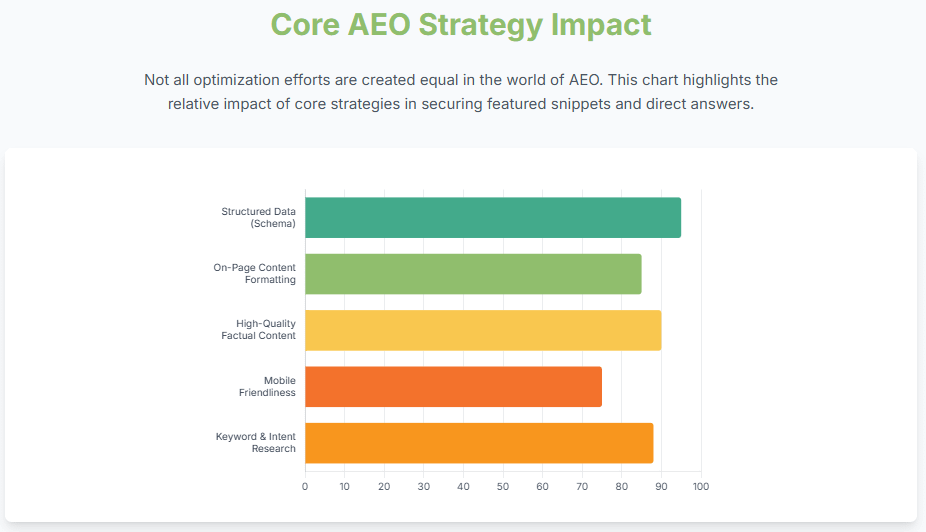
VI. The Synergy: Optimizing for Both SEO and AEO Simultaneously
How AEO strategies complement and enhance traditional SEO efforts
For any business aiming to capture traffic from all available online channels and significantly boost its search visibility, it is imperative to strategically combine both AEO and traditional SEO.1 These two approaches are not mutually exclusive but rather synergistic, designed to work seamlessly together. AEO strategies are specifically crafted to integrate effectively with existing SEO marketing strategies, collectively helping a company establish a robust and comprehensive online presence.1 This integrated approach ensures that content is optimized for both traditional keyword rankings and the direct answer format favored by modern answer engines.
Achieving holistic search visibility and maximizing organic traffic
By integrating both AEO and SEO, content is ensured to reach users across all search touchpoints: answer engines, voice assistants, and classic search results pages.1 Many AEO strategies, such as conducting conversational keyword research, structuring content for direct answers, and implementing schema markup, inherently benefit both AEO (by enabling direct answers) and traditional SEO (by improving readability, enabling rich snippets, and boosting overall rankings).1 The foundational practice of building trust and authority through high-quality, user-centric content and earning valuable backlinks is fundamental for success in both AEO and SEO.1 This comprehensive approach leads to improved overall search visibility and organic traffic, which are key goals for both optimization disciplines.1
Maintaining a consistent, humanized tone across all content
The pervasive shift towards conversational search necessitates the adoption of a simple, friendly, and consistently humanized tone across all digital content.1 This tone is crucial for building trust and fostering genuine user engagement. This humanized tone should be uniformly applied across all content, whether it is primarily optimized for traditional SEO or specifically crafted for AEO, ensuring a cohesive and authentic brand voice that resonates with users seeking direct answers.
The strong advocacy for using AEO and SEO “together” 1 for “holistic search visibility” implies that a fragmented approach, where content is optimized for SEO
or AEO in isolation, is suboptimal and will lead to missed opportunities. Instead, businesses require a unified content strategy where every piece of content is considered for its potential to serve both traditional search (ranking) and answer engine queries (direct answers). This means content planning should inherently consider both keyword rankings and direct answer potential from the outset, rather than treating them as separate optimization phases or afterthoughts. This integrated perspective maximizes the return on content investment.
Furthermore, “user experience” is repeatedly highlighted as a significant benefit and outcome of both AEO 1 and SEO.1 This indicates that providing a superior user experience is the foundational element that bridges and benefits both AEO and SEO efforts. Content that is easy to understand, directly answers questions, is well-structured, and trustworthy naturally performs better in both traditional rankings (SEO) and direct answer features (AEO). Therefore, user experience is not merely a design consideration; it is a core content optimization principle that drives success across the entire search ecosystem, ensuring that content is not only found but also valued by the end-user.
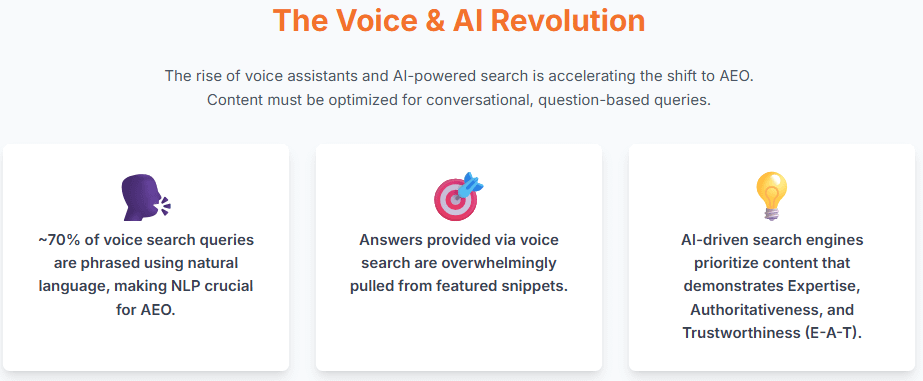
VII. Conclusion: Thriving in the Evolving Search Landscape
As the online search world continues its rapid transformation, embracing Answer Engine Optimization (AEO) has become an indispensable strategy for businesses aiming to significantly boost their online visibility.1 AEO involves leveraging powerful tools like structured data markup and developing comprehensive FAQ pages. These tactics are crucial for aligning content precisely with what users are looking for and ensuring concise, relevant answers to their most pressing questions.1 The synergy between AEO and SEO is paramount for achieving comprehensive digital success, ensuring a brand is visible and accessible across all search modalities.1
The search landscape is inherently dynamic and constantly evolving. Therefore, AEO strategies are not a one-time setup; they require regular updates, ideally at least every six months, to keep pace with changes in answer engine algorithms and shifts in user behavior.1 Consistently prioritizing user needs and proactively adapting to how people search are the fundamental keys to remaining relevant and competitive in this ever-changing environment.1 This continuous review helps ensure content remains optimally configured for answer engines and continues to provide users with exactly what they need.1
The recommendation to “update AEO strategies at least every six months” 1 strongly indicates that content strategy in the AEO era must be agile, iterative, and responsive, rather than static. This goes beyond typical SEO audits; it implies a continuous cycle of monitoring evolving user behavior, algorithm updates, and AI advancements, and then rapidly adapting both content and technical optimizations. This agile approach is critical for sustained visibility and traffic in a fast-evolving search environment where relevance can quickly diminish without constant refinement.
Furthermore, while AEO is primarily discussed in terms of visibility and traffic, the conclusion states that understanding AEO “will grow your brand’s name” and help you “become a brand people trust”.1 This implies that being consistently featured as a direct answer or a trusted source in prominent search positions builds significant brand equity and reputation. It positions the brand as an authoritative expert in its field, which can lead to long-term customer loyalty, increased direct traffic (users bypassing search engines for known trusted sources), and enhanced overall brand perception, transcending immediate search queries. AEO is not just a traffic channel; it is a powerful and subtle brand reputation builder.
By diligently applying these advanced AEO tips, a business can not only stand out prominently in today’s sophisticated search technology world but also significantly grow its brand’s name and consistently drive more organic traffic by providing users with exactly what they need, precisely when they need it.1 Embracing AEO is no longer optional; it is a strategic imperative for digital success.
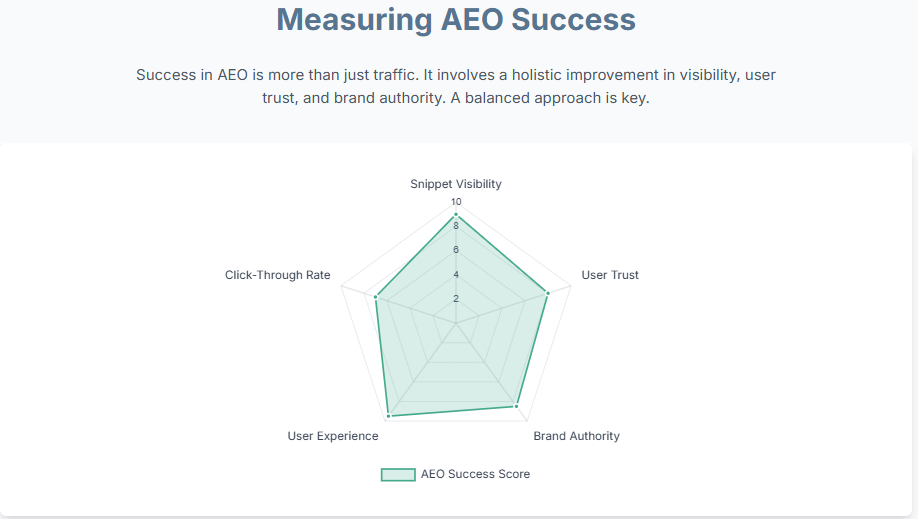
Frequently Asked Questions about AEO
1. What is the main goal of Answer Engine Optimization (AEO)?
The main goal of AEO is to give direct answers that meet user intent right in the search results page, rather than just driving clicks to a website. This helps claim featured snippets and answer boxes.
2. How does AEO help businesses?
By implementing AEO strategies, businesses can enhance online visibility, boost organic traffic, and establish authority. Featured snippets increase brand awareness and credibility, as users trust information in these prominent positions. AEO also improves user experience by quickly addressing queries with immediate solutions.
3. How often should AEO strategies be updated?
To keep up with changes, you should update AEO strategies at least every six months. Doing a regular review helps you follow updates in answer engines and adapt to shifts in user behavior, ensuring your content stays relevant.
4. What is the importance of AEO in Digital Marketing?
AEO is vital in digital marketing because it focuses on optimizing content for featured snippets and answer boxes. This provides concise, accurate answers directly on the search page, reducing the need for users to click through to a website. Integrating AEO into your digital marketing strategy is essential for capturing valuable search result space, increasing visibility, enhancing user experience, and driving traffic and conversions.

